Transmissions are vital components in modern automobiles and trucks; they convert raw engine power into mobility by utilizing gears and pinions. Sometimes, mechanical issues arise through normal wear and tear and the daily use of your vehicle. When this happens, one product to consider would be a transmission additive as an inexpensive alternative to taking your car to a mechanic for costly repairs.
Before you read any further, if your transmission fluid is over 30,000 miles old, you should always change it first to see if that fixes the problem. You can check out our guide on the Best Transmission Fluids to better understand what transmission fluid is right for you and your vehicle.
Readers who own a 2014 or newer Ford or GM vehicle running Mercon-ULV/Dexron-ULV ATF are advised not to use additives in your transmission. The current Ultra-Low-Viscosity (ULV) ATF is a very smooth oil specifically engineered not to be altered, and doing so may cause irreversible damage to your vehicle.
- Why Should You Buy a Transmission Additive?
- Top 10 Best Transmission Additives 2025
- 1. Best Overall Transmission Additive: zMAX 51-306 Transmission Formula
- 2. Best Premium Transmission Additive: Hot Shot's Secret Shift Restore
- 3. Best Performance Transmission Additive: ATP Automotive AT-203 ATF Friction Modifier
- 4. Best Budget Transmission Additive: Lucas LUC10009 Transmission Fix
- 5. Best Leak Sealing Transmission Additive: Liqui Moly 20040 ATF Additive
- 6. Best Transmission Additive for Preventative Maintenance: Prolong Super Lubricants PSL15000
- 7. Best Pre-Fill Transmission Additive: Sea Foam TT16 Trans Tune
- 8. Best Transmission Additive for Rubber Seals: Hapco Pro-Seal
- 9. Best Gel Transmission Additive: XADO Atomic Metal Conditioner Maximum (Manual or Automatic)
- 10. Best CVT Transmission Additive: Bar's Leaks 1414 CVT Transmission FIX
- Guide to Selecting the Right Transmission Additive in 2025
- Wrapping Up
Why Should You Buy a Transmission Additive?
There are three reasons why you may consider using a transmission additive: leaks, transmission noise or lack of performance, and preventative maintenance.
Stop Leaks
First and foremost, leaks from rubber seals or solenoids are among the most common gearbox problems. The rubber parts inside your transmission can be restored and repaired by adding an ester-based transmission additive.
Repair and Rejuvenation
Secondly, transmission additives can repair and clean the internal components damaged through normal wear and tear. Irregular shifts, increased noise, or grinding from within the gearbox can indicate damage to internal parts. These formulations are known as revitalizers or rejuvenators.
Maintenance and Performance
And finally, we have scheduled routine maintenance. Some additives happen to help maintain your transmission by cleaning and improving your transmission fluid’s overall quality. These additives are similar to an octane booster, where the normal fluid inside your car gets an upgrade to enhance performance to clean the junk out of the affected system.
Transmission Type
While the different types of transmission additives are the key to choosing the right product for you, you’ll also which kind of transmission your vehicle has. There are three main types of transmissions widely available today: automatic, manual, and continuously variable transmissions (CVT), and you need to make sure you purchase an additive that matches your transmission.
Some transmission issues and failures require a professional to dive deeper into the gears and grease. An additive can be useful in many situations. They remedy annoyances such as slipping gears, small leaks, minor grinding, or unsmooth shifts.
For the most part, additives are a useful alternative to save time and money by delaying potentially more expensive repairs, so read on to see our recommendations for the best transmission additive available no matter what you’re looking for.
Top 10 Best Transmission Additives 2025
1. Best Overall Transmission Additive: zMAX 51-306 Transmission Formula
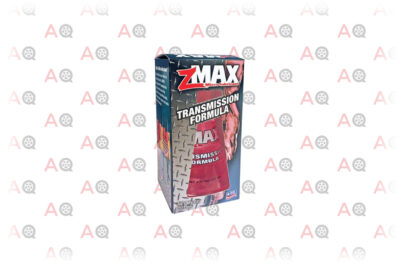
Editor’s Rating:
Compatibility: Automatic & Manual
zMax is an American lubricant manufacturer that has been around for over 80 years. The Federal Aviation Administration approved their original Linkite formula as the first pure-lubricant for piston-engine aircraft. They have since expanded to other lubricant formulations.
The zMax 51-306 reduces gear wear, improves shifting, and keeps seals supple. It does this due to its proprietary formulation of white mineral oil and ester. Unlike the Liqui-Moly 20040’s subtle approach to packaging, zMax goes full Hollywood and tries to catch the eyes of the consumer with its bright pink liquid in a conical flask.
The zMax 51-306 formulation is very potent, so much so that it removes internal varnish from heat buildup and previous transmission fluid. Be sure to wear gloves and eye protection when handling this specific additive as it is highly dangerous as a consumer product.
Almost every passenger vehicle can use the 51-306 as a preventative maintenance measure. This includes cars and trucks with both manual transmissions and automatic transmissions. Unfortunately, it will not work on vehicles with either a CVT or sealed transmission.
As a transmission additive, the 51-306 has it all. It is nearly universal, has a highly reputable company producing it, and even has an appealing aesthetic, but is it the best transmission additive today? Yes.
Assuming you do not have a CVT transmission or a sealed transmission, the 51-306 should be your choice to maintain and repair a well-used tranny is priced very competitively, is made in America by an American company, and has history and results to back up their claims. Those who do have a CVT should check out Hot Shot’s Secret Shift Restore.
Pros
- Nearly universal
- Low price
- American owned and manufactured
- Cool pink formula
Cons
- Doesn’t work on CVT or sealed transmissions
- Very dangerous to handle without PPE
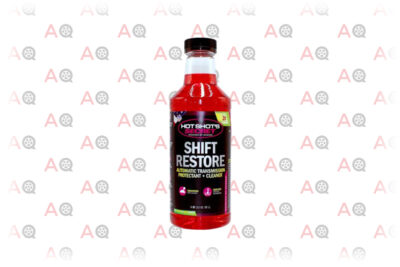
Editor’s Rating:
Compatibility: Automatic & CVT
Hot Shot’s Secret is an American automotive lubricant company based out of Mt. Gilead, Ohio. They have been manufacturing Shift Restore since 2005, and it has gone through several iterations. This product was previously sold as “Transmission Stiction Eliminator.”
HSS Shift Restore is designed to restore your automatic transmission to its original performance. The polar ester in the formula works to dissolve varnish and eliminate stiction inside the transmission. Shift Restore makes your transmission cooler, less noisy, and improves the shifting performance.
It is engineered to be used in any automatic transmission, including CVT transmissions. Unfortunately, Shift Restore does not work in manual transmissions; otherwise, this would most likely be our best overall additive. Changing your ATF before trying Shift Restore is the most optimal approach. The manufacturer recommends that you mix this at 7% per volume or 2.4 ounces per quart.
Most vehicles will get two services from one bottle of Shift Restore, thanks to the 32-ounce bottle that it comes in. The additional product comes at an extra cost. Shift Restore costs roughly double what most competitors do, such as the Lucas Transmission Fix. Despite the price, this is still a good option for those looking to perform scheduled preventative maintenance or repairs.
We would recommend Hot Shot’s Secret Shift Restore to those who have older vehicles with an automatic transmission that just isn’t running the way it used to. It is a dependable additive for those who have two cars or who drive long distances consistently.
Hot Shot’s Secret had an independent test performed on a 2006 Saab with just over 120,000 miles on it to see what exact impacts Shift Restore had on overall performance. The results are quite shocking. The independent researchers discovered approximately a 15% increase in both horsepower and torque that had previously been lost due to transmission degradation. If you would like to read the full report, click here.
Overall, HSS Shift Restore is an exciting product with hard scientific evidence backing up its claims. It can take a few hundred miles to see improvements, but you can feel the difference once the formula starts working.
Pros
- Scientifically backed product
- Made in America
- Dissolves varnish & eliminates stiction
- Automatic transmissions & CVT
Cons
- Expensive
- Oversized bottle
3. Best Performance Transmission Additive: ATP Automotive AT-203 ATF Friction Modifier
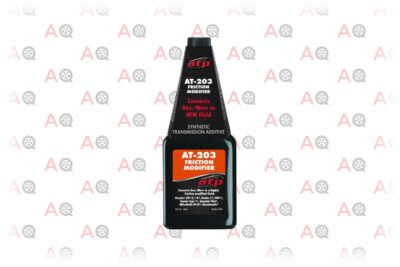
Editor’s Rating:
Compatibility: Automatic
ATP Automotive is an American company that manufactures and specializes in aftermarket automatic transmission parts and oils and has done so since 1955. ATP Automotive’s history and longevity show that high-quality products often develop when a company specializes in a specific industry sector, and the AT-203 is no exception.
The AT-203 has a unique approach to maintaining and repairing transmission seals.
Some mechanics and repair shops will use a ten-ounce bottle of AT-203 to upgrade up to 8 liters of new, less-expensive ATFs to meet or exceed the performance of expensive synthetic OEM ATFs. This is the most common use for it. However, you can also use the additive on your vehicle’s existing ATF while procrastinating a transmission flush and fill.
AT-203 is compatible with most automatic transmission fluids, including Dexron, Mercon, ATF +3, and ATF +4, Z1, T, Diamond, and Nissanmatic. Most vehicles made in Japan or the United States can take advantage of this product.
Unlike other additives, the AT-203 is a way to upgrade your existing ATF by increasing the viscosity and supplementing conventional oil into a synthetic blend. It works because of the plasticizer, Diethylene Glycol Monoethyl Ether. AT-203 effectively repairs existing rubber and EPDM-type seals found in a wide variety of vehicle transmissions.
In general, we recommend AT-203 as a cost-saving measure in contrast to expensive OEM ATFs. It will repair existing rubber seals in your transmission. This additive should be recognized as a way to increase performance while also not breaking the bank.
Pros
- American made
- Works on most American & Japanese vehicles
- Applications outside of passenger vehicles
Cons
- Automatic transmissions only
4. Best Budget Transmission Additive: Lucas LUC10009 Transmission Fix
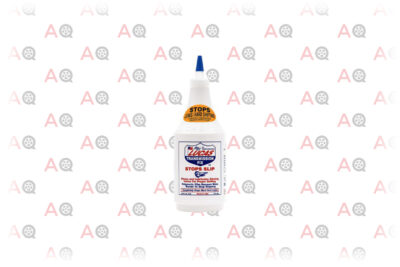
Editor’s Rating:
Compatibility: Automatic & Manual
Lucas has been a monster in American motoring and sports culture since its inception in 1989. The company has sponsored many racing teams and drivers and is most famous for its sponsorship of the Indianapolis Colts and the Lucas Oil Stadium.
In bold red letters, we see the words “Stops Slip” on the white bottle’s front. Lucas Oil designed this product for automatic transmissions that slip out of gear, experience hard shifts, or hesitate to engage gears. This additive contains friction modifiers that can improve performance inside a transmission. LUC10009 creates a polymeric film on the transmission bands to reduce slipping.
The Lucas Transmission Fix is a universal transmission additive (does not work in CVT transmissions) that even the most inexperienced car-owner can use. The additive can be added directly to the gearbox without requiring you to flush out the existing fluid.
An almost universal product is bound to have some downsides, and there is one major complaint. When it comes to seals and leaks, this product is sometimes hit or miss. The more severe the leak, the less likely the LUC100009 is going to fix it.
For more severe leaks, we recommend Liqui Moly 20040
For the most part, Lucas provides an excellent option for routine automotive maintenance at a low price. Because Lucas does not use a solvent as the main ingredient in their formulation, it is improbable that any adverse effects will come from using this product.
LCU100009 is one of the most inexpensive options if you are struggling with gear slippage and irregular shifts. We recommend the use of this product not as a stop leak, but as a stop slip.
Pros
- Inexpensive
- American made/American owned
- Stops slipping gears/hard shifting
- Near universal application
Cons
- Stop leak is subpar
- Doesn’t work on CVT
5. Best Leak Sealing Transmission Additive: Liqui Moly 20040 ATF Additive

Editor’s Rating:
Compatibility: Automatic
Liqui Moly has a long history of making high-quality lubricants and additives in racing, aviation, and military applications. While the product may not come in aesthetically pleasing packaging, the German engineering ethos of function over fashion is evident. The Liqui Moly 20040 is the newest addition to their long line of exquisite, high-quality products.
The LM 20040 additive is designed explicitly for Dexron II and Dexron III ATF and is recommended for older American-made vehicles running conventional transmission fluid. This ATF additive will improve shifting operation, dampen shifting noise, and protect against wear. LM 20040 is one of the best options to keep a smoothly operating vehicle running well into the future. With the 20040 ATF additive, Liqui Moly offers precisely what consumers need to maintain their transmission with minimal effort.
This product does a fantastic job of sealing leaks and rejuvenating seals in your transmission thanks to its very high viscosity level of 0.888g/ml. It bonds with the existing ATF to pass through all the nooks and crannies inside a modern transmission. Thanks to that high viscosity level, the additive helps certain materials reconstitute, closing leaks, and saving seals.
Overall, Liqui Moly markets a reliable option for those looking to stay up to date on transmission maintenance. While it may be slightly more expensive per ounce than other options, this additive is worth every penny if your vehicle’s transmission is compatible with it.
Pros
- Ease of use
- Great price
- High-quality German-engineered product
Cons
- Limited compatibility
- Automatic transmissions only
6. Best Transmission Additive for Preventative Maintenance: Prolong Super Lubricants PSL15000

Editor’s Rating:
Compatibility: Automatic & Manual
Prolong Super Lubricants is a California-based subsidiary of the Golden West Lubricants conglomeration. They have been making their product since the early 1990s and have had success in American auto racing in IndyCar, NASCAR, NHRA, and IMSA. Their reputation as a high-performance lubricant manufacturer has recently improved due to the success of this additive and Prolong’s secret Anti-Friction Metal Treatment.
The PSL15000 transmission additive is similar to Hot Shot’s Secret Restore in the way it eliminates stiction. The main difference is that this product actively protects the metal inside your transmission by depolarizing the ATF and creating a protective film on your parts.
This additive is an ideal choice for strictly preventative maintenance. One of the downsides of this product is that because it is doing something that is less observable, it is harder to determine the efficacy of using PSL15000. Other products are trying to stop leaks or eliminate pre-existing problems, and these are easier to determine whether or not it works.
Overall, we think that Prolong has put out a reliable product; however, it is essential to remember what each additive does and to not confuse them with each other. This product is highly recommended for owners looking to go the extra mile for planned preventative maintenance.
Pros
- Great for preventative maintenance
- American owned & operated
- Automatic & manual transmission
Cons
- Small container (8oz.)
- Hard to determine efficacy
7. Best Pre-Fill Transmission Additive: Sea Foam TT16 Trans Tune
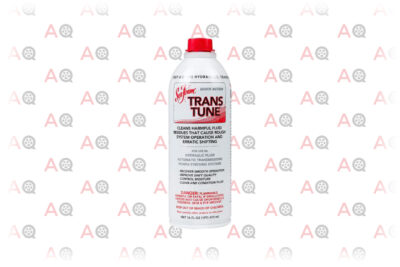
Editor’s Rating:
Compatibility: Automatic & Power Steering/Hydraulics
Founded in 1942, Sea Foam is an American company known for its automotive additives and marine lubricants. Their Sea Foam Motor Treatment is one of the best-selling automotive additives in North America. If you frequent race tracks or other car-enthusiast events, you may be familiar with their old-fashioned red and white “fairgrounds” branding.
The Sea Foam TT16 Trans Tune is an odd product that helps condition ATF and treats existing ATF. It is also one of the few products that serve as a pre-fill cleaner. A pre-fill cleaner is a product you use after you drain the old ATF. After that liquid has been removed, you put TT16 in and let it do its magic while the transmission is basically empty. It does a great job removing varnish while eliminating stiction. As a cherry on top, the TT16 Trans Tune can also stop leaks in power steering and hydraulic systems.
But there’s one glaring problem with this product. It eliminates the inconvenience of buying four different products, but at the same time doesn’t outperform any of its competitors.
One other factor directly related to this “jack-of-all-trades” approach Sea Foam is going for is that the bottle is only 16 ounces. That means that even if you want to buy it for several of the listed applications, you would probably need to purchase several bottles, and at that point, why not just buy the right products the first time?
For example, if you are looking for an additive to condition conventional ATF, the ATP Friction Modifier is the better choice, both on overall price and effectiveness.
However, TT16 is not without merits. It is relatively inexpensive and does satisfy the desire for a “one-size-fits-all” approach to automotive lubricants. If you are unsure about what product you need, Sea Foam’s Trans Fix will probably help.
Overall, Sea Form TT16’s best use is as a pre-fill cleaner. It does a fantastic job of cleaning out all the excess gunk and garbage inside your transmission. While it doesn’t compare with some of the more premium brands, it still does a reasonably good job, especially at this price point.
Pros
- Jack-of-all-trades automotive lubricant
- American company
- Best pre-fill cleaner
- Cheap
- Also a power steering/hydraulic lubricant.
Cons
- Small container (16oz.)
- Outclassed by better, more specific products
8. Best Transmission Additive for Rubber Seals: Hapco Pro-Seal
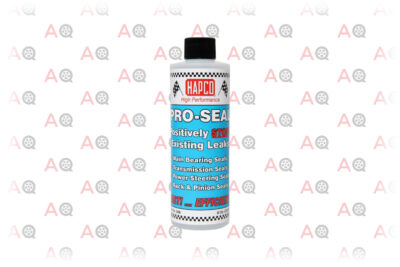
Editor’s Rating:
Compatibility: All Transmissions
Founded in Detroit in 1960, Hapco started selling vinyl and upholstery cleaners to local gas stations in Michigan. Since then, they have added to their line-up. Pro-Seal has been their best seller ever since its inception. The company has expanded, and its products are now available worldwide.
The Hapco Pro-Seal treats rubber seal related leaks in transmissions and engines, differentials, power steering, and hydraulic systems. Pro-Seal is formulated to restore old rubber seals by improving their flexibility and elasticity while also increasing the seals’ tensile strength. It does this thanks to its ester-based formulation that does not include dangerous petroleum solvents like some lesser brands.
One important thing to note is that Hapco’s Pro-Seal does not claim to fix anything other than leaks relating to rubber seals. If you are having rough shifts or slipping gears, use an additive such as the zMax 51-306 instead.
We would recommend the Hapco Pro-Seal to customers who don’t mind spending a little bit more money for a universal stop leak. The fact that it can be used on so many different parts extends this product’s usefulness substantially.
Pro-Seal comes in a small 8-ounce bottle and is usually enough for a single treatment since the formula is so highly concentrated. Hapco recommends using 1 ounce per quart of oil in your transmission. Some smaller cars will not need the entire bottle. Make sure to check your owners manual to see how much transmission fluid your vehicle needs.
Overall, Hapco’s Pro-Seal is one of the better universal stop-leaks. It makes a noticeable difference in the rubber transmission seals’ texture and elasticity and leaves you extra fluid for the next leak. Unfortunately, you also pay for that excess fluid, so the overall cost per application is similar to most other products. We recommend picking up a bottle even if it just sits on your shelf, waiting for the day you need to plug up a rubber-based leak.
Pros
- Plasticizer without solvents
- Universal rubber seal leak fix
- Made in America
- Stops leaks & rejuvenates seals
Cons
- Pricey
- Stop leak only
9. Best Gel Transmission Additive: XADO Atomic Metal Conditioner Maximum (Manual or Automatic)
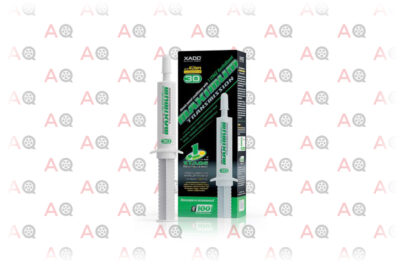
Editor’s Rating:
Compatibility: Automatic or Manual
Xado Chemicals is a Ukrainian company founded after the dissolution of the U.S.S.R., where they have manufactured and marketed many automotive lubricants and additives. They are a primary sponsor of the European soccer club Shakhtar Donetsk. It is also the largest anti-friction lubricant manufacturer globally, holding approximately 24% of the worldwide market share. XADO’s reach is mainly due to its expansion into China and the European Union.
Xado’s Atomic Metal Conditioner is a metal revitalizer. What the Hapco Pro-Seal is for rubber seals, Xado’s entry is for metal. This super condensed formula is added directly to your transmission fluid and starts revitalizing the metal components inside. One syringe treats up to 10 liters of transmission fluid and needs to be reapplied every 60,000 miles.
If your transmission doesn’t feel the same as it used to but isn’t leaking, this product might be right for you. If you notice irregular shifting, grinding, or excessive noise even after a full ATF flush, then the Atomic Metal Conditioner will be the right choice. The formula restores metal finishes, eliminating surface defects by filling in the missing metal at an atomic level by combining it into the existing material.
Xado’s Atomic Metal Conditioner has been proven to increase viscosity by up to 200%. It is even more impressive when you consider that you only need 30mL to restore the metal inside your transmission. The restorative nature of the product is consistent between both the manual and automatic transmission additives.
If the price were more in line with its competitors, it would probably be a more popular option. Sadly, this is essentially a more expensive version of the Liqui Moly 20040. Despite the hefty price tag, the impressive performance of XADO’s gel-based additive is unmatched.
This product is a clear indicator of where this market is going in the future. Transmission additives are moving away from the solvent and ester-based liquid formulations and towards a condensed, highly compact gel that is easily handled and applied with minimal hassle.
Pros
- Ultra-condensed formula
- Available for manual or automatic transmissions
- Repairs damaged metal
- Future of transmission additives
Cons
- Very expensive
- Imported
10. Best CVT Transmission Additive: Bar's Leaks 1414 CVT Transmission FIX
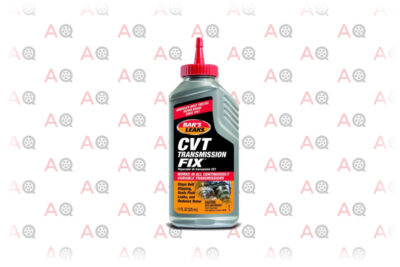
Editor’s Rating:
Compatibility: CVT
Bar’s Leaks is a Detroit-based company founded in 1947 and is still manufacturing and focusing on a single-product market, stop-leaks. They produce many different additives for transmissions, power steering units, and cooling systems. They have a solid reputation for providing quick fixes to significant annoyances or inconveniences.
Bar’s Leaks 1414 CVT Transmission FIX is designed to stop leaks and revitalize seals and should be seen as a procrastination tool rather than a repair. It lubricates and plasticizes some of the CVT-specific belts with the intention to postpone expensive maintenance. Unfortunately, CVTs are more fragile, and thus, additive driven fixes are usually only a temporary relief.
This additive is not intended for preventative maintenance but rather a stop-gap measure between discovering an issue and replacing your transmission. You may get a few weeks or even a few months of added time, depending on your CVT’s overall condition and the extent of the leaks or damage. We only recommend this product for those who cannot afford a significant car repair and need to buy some time.
Unlike other companies such as Liqui Moly and Hot Shot’s Special, Bar’s Leaks does not appear to have made any of their scientific research or findings public. This lack of transparency feels shady to us. We like to see companies that release products with the appropriate certifications and scientific data to back up their claims.
If you’re in a tight spot with a damaged or dying CVT transmission, Bar’s Leaks may offer you a temporary lifeline. However, don’t expect this to solve all of your issues. CVTs are notorious for suffering catastrophic failures, and this product is mostly a bandaid for a festering mechanical wound.
Pros
- Specifically designed for CVT
- Made in America
- Stops leaks & rejuvenates seals
Cons
- No public scientific data/research
- Not very reliable
- Not for preventative maintenance
Guide to Selecting the Right Transmission Additive in 2025
Though they often look the same at a glance, all transmission additives are not created equal. To make sure that you buy an additive that will both work for your vehicle and do what you want it to, keep the following in mind.
Types of Transmissions
There are three major types of transmissions, and knowing which one you own is the most critical determinate in making a purchasing decision.
Automatic Transmissions
Automatic Transmissions are the most common type of transmission in passenger vehicles today in the United States. Automatic Transmissions do not require you to shift or put in the clutch. You simply put the car in drive or reverse and get a move on. Automatics are the ideal option for ease of use and longevity combined as they generally last well over 150,000 miles and do not require much maintenance aside from the routine fluid change. Many common additives work with automatics, including our top overall pick.
Manual Transmissions
Manual transmissions are somewhat of a dying breed when it comes to traditional passenger vehicles. They are most commonly found today in sports cars and 4x4s. A manual transmission requires the driver to shift through gears, either assisted or unassisted.
Manuals, or standards, are seen as the hardest to learn how to drive with but still have their enthusiasts. Manual transmission additives are primarily designed to reduce heat and increase viscosity to keep the gearbox running cool and smooth. Additives that work with manuals, like this affordable but excellent Lucas additive are also common.
CVT Transmissions
Continuous Variable Transmissions (CVT) are generally more complicated than traditional automatic transmissions, and when something goes wrong, it is usually a costly repair. They are also the hardest to work on due to their belt or chain-driven design. Most newer Japanese vehicles run on a CVT, including most Hondas, Toyotas, Subarus, Lexus, and Nissans.
These transmissions require specialty transmission additives because of the belt-chain drives. These formulas are usually designed towards cleaning and stabilizing the internals of the CVT. They ensure that the belt/chain doesn’t slip or experience unwanted friction.
Some popular additives for standard automatics work well with CVTs, but there are also a few CVT-specific options on the market.
Types of Transmission Additives
What if you broke your leg, and your doctor gave you a knee brace and said, “In a few weeks, wearing this, you’ll be good as new.” You would probably simultaneously laugh and cry because of the ridiculousness of your doctor. Using the wrong transmission additive in a struggling transmission will have the same predictable results. It probably won’t fix your issue, and even if it does make the problem less obvious, underneath, the problem will still be there.
Stop Leak
Stop Leak formulations like the Liqui Moly 20040 ATF Additive usually use some combination of plasticizers and elasticizers to expand and repair existing rubberized seals. These are most commonly used in vehicles with automatic transmissions. Some companies use ester to combat leakage, while others use a mineral-based petroleum compound to stop leaks. Some even use a combination of the two.
It is crucial to double-check each additive’s active ingredients, especially if you own a CVT-propelled vehicle. CVTs should never have petroleum-based additives added to their existing fluid. The solvent can erode individual copper and electrical internalities that a CVT relies on for stable, consistent running.
If you see fluid on your garage floor or your driveway, this is the most likely remedy to your situation.
Rejuvenators
The other primary type is metal restorers and rejuvenators. These tend to work by combining and repairing, at an elemental level, the damaged, scuffed metal parts inside of a transmission that causes excessive noise, irregular shifting experience, or grinding. These products are generally also designed to remove gunky build-up known as stiction or varnish.
If you hear a rattling or crunching sound coming when you try to shift, a rejuvenating additive like Hot Shot’s Secret Shift Restore may be the answer to your prayers.
Friction Enhancer
Friction Enhancers are a specific sub-type of transmission fluid additive. They are not used for any particular problem, but rather as a way to affordably increase the quality of your existing transmission fluid by converting cheap conventional oil to a synthetic or semi-synthetic fluid.
Friction enhancing additives are sometimes combined with either a stop-leak or metal restorer to do two jobs with one product. One example of this is the Lucas LUC10009.
If you recently purchased a new-to-you used car and are unsure of the transmission state, a friction enhancer would be the safest bet to ensure long transmission life.
How Do I Use a Transmission Additive?
Always ensure your safety by wearing safety glasses, gloves, and a mask while using transmission additives. These fluids can have dangerous side effects if ingested or have contact with your skin or eyes. The fumes from many of these products can be quite intense, and so a mask will ensure that you are not directly breathing in these toxic chemicals.
Once you’ve donned your PPE, it’s a simple DIY job: just get under the hood, pull out the dipstick, and use a funnel to pour the amount indicated on the container—usually the whole thing. All that’s left is to go for a short drive—try to get out for at least thirty minutes, and shift through all of your gears. Once you’re done, the additive should be good untill you need to fully change your transmission fluid.
Disposing of Transmission Additives
The disposal of these products and excess transmission fluid should be done properly and legally.
- Collect old fluid from your transmission flush in an appropriately sized drain pan, usually at least 3 gallons.
- Pour the liquid from the drain-pan into a leak-proof container or containers. Funnels or milk jugs make this a lot easier.
- Find a local automotive fluid collection site. Some local waste facilities will have the capability of disposing of hazardous waste properly. If this does not apply to you, you can also check with chain auto-supply stores as many will accept the waste.
- Drop off the old fluid. A few waste management companies will come to you, but more likely than not, you will need to take it to a local auto supply store. Ensure your seals are tight as you don’t want to spill that waste all over your vehicle.
Use the Environmental Protection Agency’s website to determine where you should dispose of your old oil and other automotive fluids.
Wrapping Up
There are so many potential benefits from regularly using a transmission additive, both long-term and short-term. The best transmission additives can save you money, reduce wear and tear, reverse leaks, and repair damaged parts. Preventative maintenance is crucial to ensuring your vehicle has the longest life it possibly can. We hope that this guide has empowered you to make the correct decision regarding selecting a suitable additive for your transmission.


